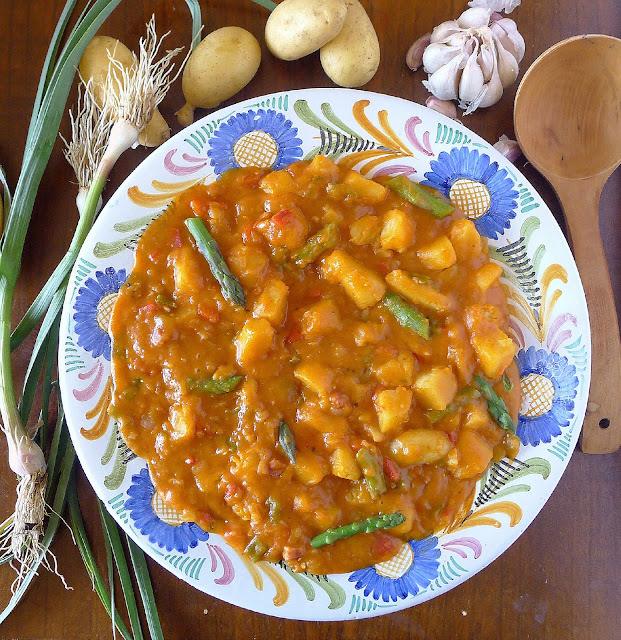I bet you didn’t know that Almería is this year’s Capital of Gastronomy in Spain. Do you even know where Almería is? It’s a province of Andalusia that shares a Mediterranean coast with Málaga and Granada and, to the east, Murcia and Alicante. But, while those provinces are on the beaten track of tourism, Almería is better known for its tomatoes.
 |
| Little flatbreads called torticas are the essence of Mediterranean foods--fresh fish, vegetables, olive oil--baked in a cornmeal shell. |
Tomatoes and melons and peppers. Pink shrimp, red mullet, octopus. Fine lamb and baby kid. The city of Almería and the surrounding province have all the raw ingredients for fine gastronomy. This is the region of hothouse-grown vegetables, providing fresh produce all winter long to the rest of Spain and Europe. It’s a major fishing port. Yes, there are beautiful beaches, too. And, Hollywood film locations at the inland “badlands” (all those Clint Eastwood “spaghetti westerns” were made here).
During the gastronomy year, Almería is featuring different themes and products every month. May has been “melones, sandías y cremas frías” (melons, watermelons and cold cream soups). Next month, June, the theme is “la cocina de vanguardia” (vanguard cuisine). (More information about events here. )
Today I’m making a specialty from the Almería town of Vera, Torticas de Avío, sometimes called Almería “pizza.” It’s a flatbread made of cornmeal, topped with those quintessential Mediterranean ingredients, anchovies, tomatoes, onions and peppers. The topping is flavored with oregano and a good bit of cumin. My only addition to the traditional recipe is capers, which I think add a nice punch. The next time I make the torticas, I might use some wheat flour with the cornmeal. If you can't find fresh anchovies, try using oil-packed ones or even canned sardines.
The flatbread can be made any shape or size. These small ones make nice appetizers or starters.
 |
| Small flatbreads are like tarts. The filling bakes right in the shells. |
 |
| Oregano and cumin flavour the filling mix. |
 |
| Eat these "pizzas" out of hand, a grab and go snack. |
 |
| Or serve them plated as a starter. They are best served room temperature. |
Almería “Pizza” (Cornmeal Flatbreads with Anchovies)
Torticas de Avío
Torticas de Avío
 |
| Fresh anchovies have been filleted. |
Makes 8 (4-inch) tarts.
For the filling:
1 pound fresh anchovies
1 cup chopped tomatoes
1 cup chopped onion
1 cup chopped green pepper
3-4 cloves garlic, chopped
2 teaspoons oregano
½ teaspoon cumin
1 teaspoon coarse salt
Freshly ground black pepper
3 tablespoons olive oil
Capers (optional)
1 pound fresh anchovies
1 cup chopped tomatoes
1 cup chopped onion
1 cup chopped green pepper
3-4 cloves garlic, chopped
2 teaspoons oregano
½ teaspoon cumin
1 teaspoon coarse salt
Freshly ground black pepper
3 tablespoons olive oil
Capers (optional)
For the cornmeal crust:
3 cups yellow cornmeal
2 teaspoons salt
1 tablespoon olive oil
1 ½ cups hot water
3 cups yellow cornmeal
2 teaspoons salt
1 tablespoon olive oil
1 ½ cups hot water
Clean the anchovies. Cut off the heads and pull out the guts. Use thumb or knife point to lift the spine and pull it down to the tail. Cut off and discard the spine, leaving two fillets attached at the tail. Wash and drain the anchovies and pat them dry with paper towels.
 |
| Macerate anchovies with the vegetables. |
In a mixing bowl combine the tomatoes, onion, green pepper, garlic, oregano, cumin, salt, pepper and 2 tablespoons of the oil. Add capers, if using. Add the anchovies to the vegetables. (Cut them into pieces, if you prefer.) Let the mixture macerate while preparing the dough for the crusts.
Place the cornmeal in a bowl and mix in the salt. Drizzle with the 1 tablespoon of oil. Add 1 cup of the water and stir to combine well. Add enough of the remaining water to make a soft dough that can be gathered into a ball. Divide the dough into 8 balls and set them aside.
Preheat oven to 325ºF.
 |
| Press ball of dough into a round, make a rim. |
Line a baking sheet with baking parchment. Space the balls of dough on the sheet (use 2 sheets, if necessary). Use fingertips to flatten the balls into 4-inch rounds, about ¼ inch thick. Pinch around the edges to turn up a rim to contain the filling.
Spoon the anchovy-vegetable mixture into the tart shells. Drizzle the remaining 1 tablespoon of oil over them.
Bake the tarts 25 minutes. Raise the oven temperature to 400ºF and bake 10 minutes more. Cool the tarts on a rack. Serve them room temperature.
Food and travel writer, Gerry Dawes, says the best food he ate on a recent trip to Almería was cooked to order at a café-bar within the Mercado Central, or central market. Read his report here.
More recipes from Almería:
More pizza and flatbread recipes:
More recipes with fresh anchovies:


















